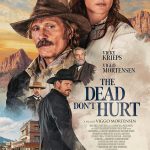When a locket is removed from a collapsed fire tower in the woods that entombs the rotting corpse of Johnny, a vengeful spirit spurred on by a horrific 60-year old crime, his body is resurrected and becomes hellbent on retrieving it.
Chuck says:
Having gotten a rapturous reception at various film festivals, Chris Nash’s “In a Violent Nature” is being touted as a piece of art house horror, a film cut from the same cloth as “The Blair Witch Project” or “The Witch.” To be sure, it does contain elements that would justify this, the filmmaker creating a genuinely unnerving sense of time and place that elevates it above similar efforts.
However, the effort to put “Nature” on equal footing as the two previously mentioned classics is a bit of a reach. For all the obvious skill that has gone into it, there’s little in the way of radical redesign where its plot is concerned. That being said, when Nash employs a subtle approach, the movie is at its most effective. It’s only when he gives in to his most base artistic instincts that he hobbles this effort.
To his credit, Nash dispenses with the genre tropes quickly. A group of teens, camping in the Canadian wilderness, stumble upon ruined structure in the woods, in the middle of which is a metal pool from which hangs a gold chain and locket. Impulsively, one of them takes this tattered piece of jewelry, in the process paving the way for the resurrection of an unstoppable evil. Only later, around an appropriately creepy campfire, are we told the Legend of Johnny, an overgrown, “mentally hindered” teenager who was brutally killed by a group of lumberjacks from the area…or so they thought. Seems he was able to exact revenge on his killers, a slaughter known to the locals as the “White Pines Massacre,” before being taken down and interred far in the woods, his mother’s necklace, hung over his grave, keeping him in check.
More of the backstory is provided later but it is typical of slasher movies of this sort – it holds no water, and it is of little consequence. All that’s important in slasher films and to their fans is that there’s an unstoppable killer on the loose and grisly murders are in the offing. This isn’t initially the case, as Johnny’s first victim, who has the temerity to be living in his family’s long-abandoned house, is done with relative taste and restraint. Unfortunately, this is not too last, Johnny’s handiwork becoming increasingly vile and disturbing. One of the kills is particularly outlandish and grotesque, but the on-line response to it by slasher fans is of the greatest concern, their praise for this sort of gruesomeness, disturbing.
Yet, Nash creates a seductive approach with two obvious, subtle choices. There is no music in the movie, no thundering, ironic score to punctuate the violence or announce Johnny’s arrival. The result is jarring, the absence of the expected aural cues creating a sense of realism that gets under your skin and only highlights the brutality on display. This, coupled with Nash’s decision to keep the camera constantly behind Johnny, so that we share his perspective throughout. This creates a sense of shared identity between killer and viewer, the result being an uneasy kind of sympathy for him.
These two very simple techniques make for an, at times genuinely unnerving experience. Ironically, at times it makes for a dull one as well. Traipsing around all day and half the night with a member of the undead is rather monotonous. Still and all, Nash’s less-is-more approach in generating an eerie mood and unique perspective proves effective. Had he taken the same approach where the film’s violence is concerned, then “Nature” may have in fact been considered a work of art.
2 1/2 Stars
Recent Posts




